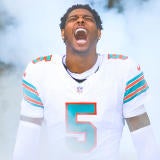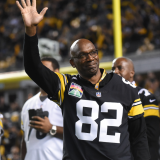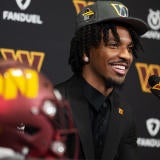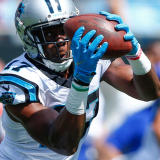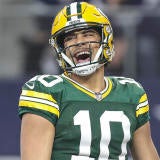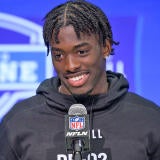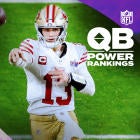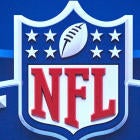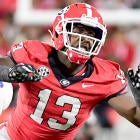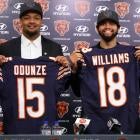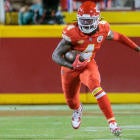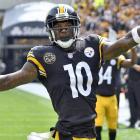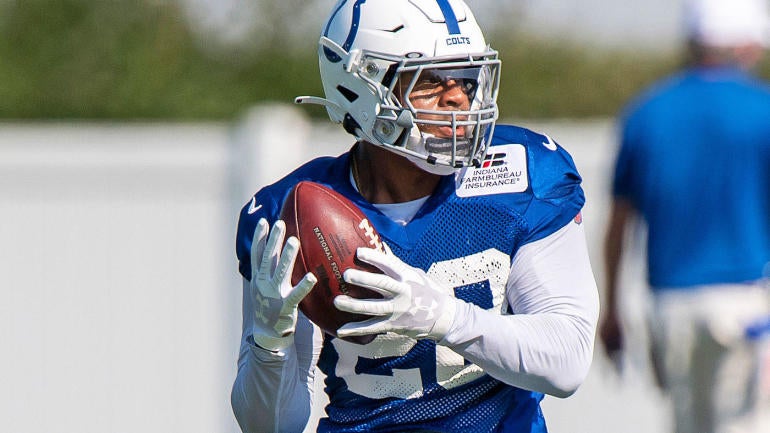
While not nearly as hyped as the wide receiver class, the 2020 draft did feature a handful of highly talented running backs. Three were picked in the top 50 and six were selected before the start of the third round. And now we've gotten updates on how these young ball carriers have fared over the first few weeks of training camp.
Now that we've been able to see these runners on the field, it's time to reset the position not just by overall talent but by opportunity and situation that altogether indicate how big of an impact these rookie backs will make in 2020.
Will Brinson and Heath Cummings covered many things Fantasy on the Pick Six Podcast, including why you shouldn't set expectations too high for rookie running backs. Give it a listen below, and be sure to subscribe:
10. DeeJay Dallas, Seahawks
Skill set: Squatty, vision-based back with high-quality hands and deceptive bounce in space.
2020 impact: Dallas averaged 5.7 and 6.0 yards per carry in his final two seasons at Miami, although he never carried the ball over 115 times either year. Not remotely close to being a special athlete, Dallas wins with low-center-of-gravity power and high-level balance through tackles he can't avoid. With former first-round pick Rashad Penny on active/PUP right now nursing an ACL injury, Dallas has an outstanding opportunity in front of him, and according to Liz Matthews of The Seahawks Wire, Dallas has made a "really good impression" on Pete Carroll early in camp. Seattle's head coach singled out the rookie runner's pass-catching ability.
Seattle's backfield is led by Chris Carson and has other depth options, including newly signed Carlos Hyde and Dallas' former Miami teammate Travis Homer, but Dallas should carve out a nice, receiving role as a rookie.
9. Eno Benjamin, Cardinals
Skill set: Springy, contact-balance specialist with reliable hands and explosive movements.
2020 impact: Benjamin was a productive workhorse at Arizona State in 2018 and 2019 then measured in at a stocky 5-foot-9 and 207 pounds at the combine. There he ran 4.57 -- not great -- but had a vertical in the 90th percentile at the position and a three-cone drill in under 7.00 seconds. His game is predicated on short-area explosion, outstanding vision, and the innate ability to maintain his equilibrium when contacted. While not deemed ultra-serious, Kenyan Drake is in a walking boot right now at Cardinals camp, and Benjamin only has Chase Edmonds in front of him on the depth chart. This is me telling you to not be surprised when Benjamin is contributing for Arizona in a big way at some point during his rookie year. He's the perfect Air Raid back.
8. Darrynton Evans, Titans
Skill set: Speedy, dynamic acceleration-based slasher who'll work best in a zone-heavy system.
2020 impact: Evans ran 4.41 at the combine at over 200 pounds with a 37-inch vertical. He's twitched up in his lower half. His lateral agility leaves a little to be desired, but on runs with zone-blocking in front of it, all he'll need to do is find the hole, plant his foot, and go. That's exactly what he did, over and over, at Appalachian State. In three years for the Mountaineers, Evans averaged 6.0 yards per carry on 482 attempts.
He's had some fumbling issues early on at camp, according to Terry McCormick of TitansInsider.com, but there's really no legitimate competition for Evans to be Derrick Henry's backup. And while Henry is part human, part robotic moose, he is coming off a season in which he carried the ball 389 times (including the playoffs).
7. J.K. Dobbins, Ravens
Skill set: Bulky back with a complete skill-set but lacks a true trump card.
2020 impact: While Jeff Zreibec of The Athletic wrote "every practice seems to bring another highlight-reel submission" from the rookie runner, there is Mark Ingram, Gus Edwards, 2019 third-round pick Justice Hill and that Lamar Jackson fellow as run-game weapons in Baltimore.
Dobbins does routinely find holes quickly, has solid acceleration, some jump-cut capabilities, and an occasional moment of downfield speed. The Ravens are more than likely going to run it more than any other team in the league once again, and Dobbins will get his touches, he's just further down the list despite being a refined back because of the other capable ball carriers at offensive coordinator Greg Roman's disposal.
6. Antonio Gibson, Washington
Skill set: Bowling ball of a back with light-speed wheels and quality hands from his days as a receiver in college.
2020 impact: During the 2019 college football season, I was only scouting Gibson as a receiver ... because that's what he was. And I was enamored with the way he made light work of running by cornerbacks down the field. Then, starting in late October, Gibson received 30 carries and accumulated 364 yards. Yeah. 364 yards on 30 carries. He was a big play waiting to happen as a runner. Oh, and he averaged 19.3 yards per reception in 2019.
At a rocked up 6-0 and 228 pounds at the combine, Gibson blazed to a 4.39 and had a 35-inch vertical. He's still learning the fundamentals of playing the running back position -- particularly how to read and cut off blocks -- but his rare explosiveness and receiving prowess will be welcomed in a Washington offense searching for viable options after Terry McLaurin.
5. D'Andre Swift, Lions
Skill set: Thick back who excels as a receiver but lacks natural elusiveness.
2020 impact: I'm one of the few who wasn't nearly as high on Swift as the masses. He's a natural catcher of the football and does have a nice size/speed combination at 5-8 and 212 with 4.48 jets. Will he make defenders miss with great regularity in the NFL? I just don't see that happening. He'll run with authority, which should help him get more than what's blocked to a certain degree.
While he's drawn rave reviews for his pass-catching ability early at camp, Swift did suffer a leg injury at camp a week ago. Kerryon Johnson still projects to be the starter in Detroit for the time being. But Swift doesn't have any major competition for the 1B role in the Lions' backfield.
4. Zack Moss, Bills
Skill set: Serious power back with a fire hydrant frame and surprising lateral agility to elude second-level defenders.
2020 impact: Moss has 2019 third-round pick Devin Singletary squarely in front of him on Buffalo's running back depth chart. That doesn't mean the rookie won't be a large part of what the Bills want to do on the ground this season. At 5-9 and 223 pounds, Moss naturally plays with a low center of gravity and has tree trunks for legs, so he brings it as a power back. But there's a lot more to his game than that. When needed, he can glide laterally or absorb contact to accumulate extra yardage. And, he was a major producer in the pass game last year at Utah, catching 28 passes for 388 yards -- 13.4 yards per.
The Athletic's Joe Buscaglia has made mention of Moss' receiving skills early in camp, and while the Bills are poised to throw more frequently this year than they did in 2019 given the trade to acquire Stefon Diggs, Buffalo did finish sixth in team rushing attempts last season.
3. Clyde Edwards-Helaire, Chiefs
Skill set: Ultra-agile receiving back with a frame built impossibly low to the ground.
2020 impact: I didn't think Edwards-Helaire was the best back in the 2020 draft class. But he was the most exquisite fit with Patrick Mahomes, Andy Reid and the Chiefs. He was Joe Burrow's go-to, check-down option and was a nightmare to corral in the SEC thanks to his smaller frame that allows him to hide behind his blockers, high-end contact balance, and most namely his ultra-bouncy agility in tight quarters. He's the unquestioned top back in the Kansas City's fireworks display of an offense.
The only reason(s) he isn't higher -- Tyreek Hill, Travis Kelce, and to a lesser extent, Mecole Hardman and Sammy Watkins.
2. Cam Akers, Rams
Skill set: Dynamic, well-round back with inherent elusiveness and burner-type downfield speed.
2020 impact: The numbers flat-out lie when it comes to Akers' collegiate career. He was significantly better than his career 4.9 yards-per-carry average would indicate. In fact, averaging 4.4 yards per carry in 2018 was a minor miracle given the atrocity that was Florida State's offensive line than year. He runs with suddenness, instant acceleration once he receives the handoff, violent cuts at any level of the field, and 4.47 speed. The second-round selection is set to be the feature back in Sean McVay's proven system, and Akers has the immense talent to take off immediately. And will.
1. Jonathan Taylor, Colts
Skill set: Big, fast, athletic, boulder of a back tailor-made to knife between the tackles as an NFL feature back
2020 impact: Technically, Taylor has Marlon Mack as legitimate competition in Indianapolis' backfield. Mack's a talented player. But he's not on Taylor's level, and the Colts used a second-round pick on the Wisconsin running back legend in the 2020 draft. Taylor's film showed every possible skill anyone would want in a running back -- exploding through tackle attempts, deploying multiple cuts on inside runs, the bounce to take it outside when need be, and the long speed to hit home runs.
At 5-10 and a chiseled 226 pounds, Taylor left a trail of smoke behind him in the 40-yard dash at the combine, running 4.39. He had a vertical in the 70th percentile and broad jump in the 80th. Indianapolis probably has the best offensive line in football. Despite Mack's presence, Taylor will make the largest first-year impact among all rookie runners.



























